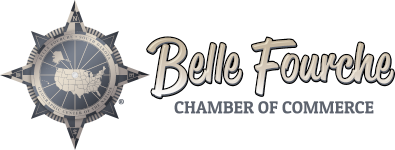Advocating for Businesses in Belle Fourche since 1911.
The Chamber is the Spirit of the People...
1889
It is the voice of the Main Street and business community. Sometimes it was a cry in the wilderness. For many years, it was the only civic organization in Belle Fourche. It is a united effort.
The civic urge was generated on Butte Country’s frontier even before Belle Fourche was founded. The first civic club was the Minnesela Board of Trade organized June 8, 1889.
Minnesela, seat of Butte County, was the little trade center located on Red Water River two miles east of present day Belle Fourche. The Board of Trade’s goal was a railroad to provide a shipping outlet for the cattle populating the tri-state range. Minnesela’s boosters failed in this quest. The Freemont & Elkhorn & Missouri Valley Railroad, advancing from Whitewood were induced to bypass Minnesela and build a station. atthe Belle Fourche River, then extend their tracks two miles farther west to Middle Creek where shipping yards to accommodate the livestock industry were built.
In the early 1880s a stage station had been located at the river crossing site, name DeMoris, on the Medora-Deadowood lne. The railroad depot sided the location and a new town grew up around it. This town was Belle Fourche.
1890
On the new frontier ethics were ignored to gain the desired end. Belle Fourche was a boom town from the start. The railroad arrived in midsummer and in the fall of 1890 over 3,000 car loads of cattle were been shipped from the Middle Creek yards.
In the fight for the county seat, Belle Fourche boosters offered a new courthouse as a free gift to voters if they would move the seat from Minnesela to Belle Fourche. An influx of loafers from Hills mining camps via the railroad, helped Belle Fourche cast enough votes to win the election. From then on, Belle Fourche thrived while Minnesela became a memory.
1895
In 1895, a fire destroyed half the town’s buiness district in and with faith in the future, Belle Fourch built up again in 1896.
1896
This unity of purpose brought about the organizing of. the first Businessmen’s Club in 1896. The Belle Fourche Club joined the Black Hills Improvement Association, the regional organization at the time, to push industrial developments in the Hills country.
1904
During the Spanish-American War years the club died out, but in 1904 a second club was organized with Dr. J L. Townsend as president. The need then was a daily mail route to Spearfish, a county fair at Belle Fourche, and a decision to hold by-weekly meetings.
1905
In 1905, W.W. Read was elected president. Now the big push was to get the Federal Irrigation Dam and Project for Butte County.
1907
In 1907, the businessmen gathered in Pearson’s new opera house. The goal was to put Belle Fourche on the map, and work for better stock train service.
1908
In 1908, the club elected W. B. Penfold as president. The program stressed bridges across Redwater at Eaton’s farm, a bridge across the Belle Fourche River on the north end of Fourth Avenue, and a bridge across Crow Creek north of town.
1909
The officers carried over and in 1909, the club tried for free Carnegie Library and put up a fight to keep the Herd Law out of western South Dakota.
With the big dam built, irrigation an assured fact, and a new era of promise. In the picture were a homesteading influx, attracted by irrigation, free lands, a rail line down the Belle Fourche valley, and the new towns of Fruitdale, Nisland, and Newell. The Butte County boom was on.
Chamber Founding in 1911
Old business club practices had to give way to new and better organization. In January 1911, the members gathered in the courthouse to reorganize. The Belle Fouche Commercial Club was formed.
During the next half century the Chamber worked at many projects and did many things: industry included exhibits at the state fair and at industrial shows. An alfalfa mill was started, a room factory, a soap making plant, a beet sugar factory, roller mill, saw mill, brick yards, bentonite mining and milling was encouraged and wool scouring prospecting were investigated at considerable expense a number of times.
Civic improvements aided or sponsored by Chamber activities were airports, mail services, US land office, street oil, gravel and paving, street lights, telephone services, legislation, water works, city band, park and now plowing to ranches, plane surveys, postoffice building, courthouse and community halls.
The Chamber took the lead in promotion of hospitals, hotels, theatre , schools, and tourist facilities. During those 50 years the community spirit was damped by floods, epidemics, and liquor business.
War-Time Efforts
During the three wars spanned by the half century, the Chamber got in some of its most effective work. Under war times, efforts were patriotic parades, bond, scrap-iron and rubber drives, supervising food rationing, providing labor where needed, making post war surveys, organizing the local post of the American Legion, honoring war dead returned for burial and supporting the home guards and the National Guard stationed in Belle Fourche.
Agricultural Cornerstone
Agriculture is a corner stone of regional economy. Chambers of the past have participated in reclamation conventions, beet growing programs, water storage compacts, promoted pickle growing industry, defended Experiment Farm at Newell, aided in fairs, 4-H Club events, and beet field tours. Chamber urged beet growing expansion to attract a sugar factory by the Utah-Idaho Sugar Company.
This is a glimpse at the very beginning.
